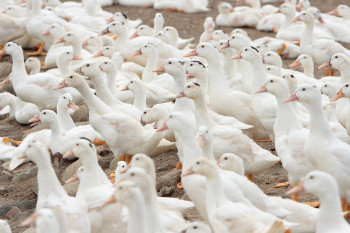June 1, 2010
Pandemic Influenza: the role of poultry birds
 Never in history of mankind have we reared as many pigs and chickens as now. The growing demand for meat, especially in developing countries like China, exerts a great pressure in the increase of the quantity of meat in commerce. Therefore, more wild birds are being caught and more domestic birds are being bred. The increase in the production results in the increase of more breeding sites, more animal transportation and higher density of animals. All conditions that favor the Influenza.
Never in history of mankind have we reared as many pigs and chickens as now. The growing demand for meat, especially in developing countries like China, exerts a great pressure in the increase of the quantity of meat in commerce. Therefore, more wild birds are being caught and more domestic birds are being bred. The increase in the production results in the increase of more breeding sites, more animal transportation and higher density of animals. All conditions that favor the Influenza.
![]() In this context, chickens and ducks are our focus of attention. The origin and higher diversity of the Influenza is found in aquatic birds. They are the natural reservoir of Influenza and the source of all the lineages that infect humans and pigs, and their consequent mixtures such as the Influenza A (H1N1). While the human and swine Influenza lineages only have H1, H2 and H3, and N1 and N2, birds have all the known types of Hemagglutinin and Neuraminidase, H1 to 16 and N1 to 9, spread over more than 100 species already identified as carriers. [1]
In this context, chickens and ducks are our focus of attention. The origin and higher diversity of the Influenza is found in aquatic birds. They are the natural reservoir of Influenza and the source of all the lineages that infect humans and pigs, and their consequent mixtures such as the Influenza A (H1N1). While the human and swine Influenza lineages only have H1, H2 and H3, and N1 and N2, birds have all the known types of Hemagglutinin and Neuraminidase, H1 to 16 and N1 to 9, spread over more than 100 species already identified as carriers. [1]
Our close coexistence with these animals allows any lineage that infects them to have more chances of entering us humans. It is what has been happening to H5N1, which in most cases was transmitted to those who reared poultry birds or persons close to them. No matter how small are the chances of being transmitted to humans, as we have receptors unfavorable to the virus in our respiratory tract, the events of contact are very often.
The Asian poultry market is a place where the presence of the avian virus is constant as well as contagious. Migratory wild birds, carriers of an enormous diversity of Influenza, come in contact with domestic birds such as chickens, geese, quails and ducks that serve as intermediaries for viruses that were restricted to the wild. The coexistence of these birds with the breeders, sellers and with pigs is a high source of opportunities for the entry of new viruses. It is not by chance that Asia has been the frequent source of new Influenzas, pandemic or not. The origin of the Influenza A (H1N1) in Mexico is a bit uncommon.
The Influenza H9N2, for instance, was established as a circulating lineage in domestic birds and was isolated for the first time in turkeys in North America in 1966. In Asia, on the other hand, it circulated mostly in ducks and from then on it also began to circulate in chickens as of 1990. Although we are not concerned about H9N2, which causes mild symptoms in a few contaminated people, its presence in chickens (or quails, the virus that contains the closest genes was isolated from one) probably caused the rearrangement that generated the highly pathogenic H5N1, giving genes to an H5N1 from geese. That is, the Influenza in domestic birds can be a huge problem, even indirectly. [2]
Therefore, the transmission of new lineages of Influenza is inevitable. An event most likely to prevent and monitor, but more and more likely to happen. Our urban life style, filled with a protein rich diet from animal origin, is one of the ingredients of our long life and life quality but it is also a growing source of the problems we face.
Sources:
[1] Dugan, V., Chen, R., Spiro, D., Sengamalay, N., Zaborsky, J., Ghedin, E., Nolting, J., Swayne, D., Runstadler, J., Happ, G., Senne, D., Wang, R., Slemons, R., Holmes, E., & Taubenberger, J. (2008). The Evolutionary Genetics and Emergence of Avian Influenza Viruses in Wild Birds PLoS Pathogens, 4 (5) DOI: 10.1371/journal.ppat.1000076
[2] Guan, Y. (1999). Molecular characterization of H9N2 influenza viruses: Were they the donors of the “internal” genes of H5N1 viruses in Hong Kong? Proceedings of the National Academy of Sciences, 96 (16), 9363-9367 DOI: 10.1073/pnas.96.16.9363


[...] The growing demand for meat, especially in developing countries, has lead to unprecedented numbers of pigs and chickens. Increased production leads to more breeding sites, more animal transportation, and higher animal density – conditions that favor transmission of influenza virus. [...]